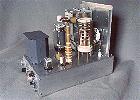

Which Type of Crystal to Use:
If at all possible use crystals in a real FT-243 pressure holder. The
metal pressure plates that hold the crystal in this type of holder help to
dissipate heat and minimize the crirp caused by the expansion of the crystal.
Other crystals with the same pin diameter and spacing are available, and they
will work, but these have plated on electrodes, which do not diissipate the
heat very well, and thus they chirp or "whoop" terribly. This is
especially true the higher the frequency of the crystal.
Choice of Crystal Frequency:
The power output of the 6CL6 transmitter depends on the band of operation and
the frequency of the crystal used. The transmitter can operate on the crystal
fundamental, or double, triple, or quadruple the crystal frequency to the
desired output. In all cases, the lower the crystal frequency for a given
band, the better the keying. Unfortunately, the usual tradeoff is involved:
when multiplying a lower crystal frequency to obtain an output at a higher
frequency, less output is obtained and the harmonic content of the output
increases. Since there are no intermediate stages in the transmitter to
filter out unwanted harmonices, good amateur practice implies that when
operating the transmitter as a multiplier you should use an antenna matching
network ("Antenna Tuner") or bandpass filter on the output to
attenuate any unwanted harmonics and make sure that they don't get
radiated. Also, be sure that you don't accidently tune up the transmitter
on the wrong band! (This is also possible with many vintage commercial
transmitters as well!)
The table below summarizes the crystal frequencies that can be used on each band:
| Band: | Crystal Frequency and Mode: |
| 80m | 3.5 MHz - Fundamental |
| 40m | 3.5 MHz - Doubler, 7 MHz - Fundamental |
| 30m | 5 MHz - Doubler |
| 20m | 3.5 MHz - Quadrupler, 7 MHz - Doubler |
| 15m | 7 MHz - Tripler |
I take the lower output as a challenge, and prefer the better keying, so I use 3.5 MHZ (80m) crystals on 80, 40, and 20m. On 15m I have found that 3.5 MHz crystals give no useful output, so I use 7 MHz (40m) crystals on that band. I always have an antenna matching network in-line to insure that no harmonics get to the antenna
By the way, I see no reason why you couldn't use 1.8 MHz crystals (160m) and double to 80m, or use 3.37 MHz crystals and triple to 30m, if you happen to have such crystals around. They could theoretically give better keying on those bands.
Power Output Measurements:
The transmitter was operated on several different bands in several different
multiplying modes, and the output was measured with a Bird Wattmeter. The
results are summarized in the table below:
| Band: | Crystal Frequency: | Mode: | Power Output: |
| 40m | 3.5 MHz | Doubler | 4 watts |
| 40m | 7 MHz | Fundamental | 5 watts |
| 20m | 3.5 MHz | Quadrupler | 2 watts |
| 20m | 7 MHz | Doubler | 3.25 Watts |
| 15m | 7 MHz | Tripler | 1.25 watts |
 Click here for pictures and information on the Wingfoot
VFO 2E26 Exciter
Click here for pictures and information on the Wingfoot
VFO 2E26 Exciter Click here for pictures and information on the Wingfoot
813 Amplifier
Click here for pictures and information on the Wingfoot
813 Amplifier Back to Dr.
Greg Latta's Electrical Engineering and Amateur Radio Pages
Back to Dr.
Greg Latta's Electrical Engineering and Amateur Radio Pages
 If you have any questions or
comments, you can send E-Mail to Dr. Greg Latta at
glatta@frostburg.edu
If you have any questions or
comments, you can send E-Mail to Dr. Greg Latta at
glatta@frostburg.edu
This page is under constant revision. Please check back often.